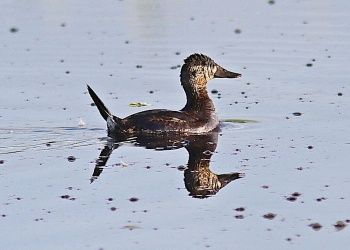- Oxyura jamaicensis
Identification
Length 35–43 cm, wingspan 53-62 cm, weight 310-800 g
A small diving duck. Compact body with large head and stiff tail often cocked up, give it a very distinctive shape. Wings plain dark brown in all ages and seasons.
Breeding male
- Striking blue bill
- Black head with white cheeks
- Red-brown body
Non-breeding male
- Grey-brown body
- Head much as summer male but slightly duller
- Unlike most ducks, the non-breeding 'eclipse' plumage is seen from late fall through winter to early spring, not late summer
Female
- Dull brown
- Striped dark brown and pale buff head pattern
Juvenile
- Very similar to female; young males slowly gain white cheeks in first winter
Distribution

Photo © by Stanley Jones
Laguna Cartagena NWR, Puerto Rico, USA, November 2012
Native to North, Central America and the Caribbean.
Introduced to the UK and Europe, where hybridisation with White-headed Duck is causing some concern.
Taxonomy
This is a monotypic species1.
Andean Duck was formerly included in this species.
The subspecies rubida from the northern part of its range is usually no longer accepted.
Closely related to the other "stifftails" of the genus Oxyura
Habitat
Marshes, ponds and lakes with areas of open water and emergent vegetation.
Behaviour
Action
Dives to feed. Often sinks low in water before diving or even sinks completely to feed without diving.
Rarely seen on land as it walks poorly. They are not often seen in flight.
It cocks the tail much of the time. Except when on the nest spends much time on open water or diving for food.
Diet
A diving duck.
Their diet consists of aquatic insects, molluscs, crustaceans and worms. Also aquatic plant seeds.
Breeding
Breeding season varies through range, breeds all year in the tropics, April to August in the northern parts of its range.
A seasonally monogamous species. The nest is a bowl made of dead vegetation on ground or on water, hidden in dense vegetation. Lays 6 to 10 eggs.
References
- Clements, J. F., T. S. Schulenberg, M. J. Iliff, D. Roberson, T. A. Fredericks, B. L. Sullivan, and C. L. Wood. 2018. The eBird/Clements checklist of birds of the world: v2018. Downloaded from http://www.birds.cornell.edu/clementschecklist/download/
- Gill, F and D Donsker (Eds). 2017. IOC World Bird Names (version 7.2). Available at http://www.worldbirdnames.org/.
- Del Hoyo, J, A Elliot, and J Sargatal, eds. 1992. Handbook of the Birds of the World. Volume 1: Ostrich to Ducks. Barcelona: Lynx Edicions. ISBN 978-8487334108
- Handbook of the Birds of the World Alive (retrieved December 2014)
- BF Member Observations
Recommended Citation
- BirdForum Opus contributors. (2024) Ruddy Duck. In: BirdForum, the forum for wild birds and birding. Retrieved 17 November 2024 from https://www.birdforum.net/opus/Ruddy_Duck
External Links
GSearch checked for 2020 platform.1





